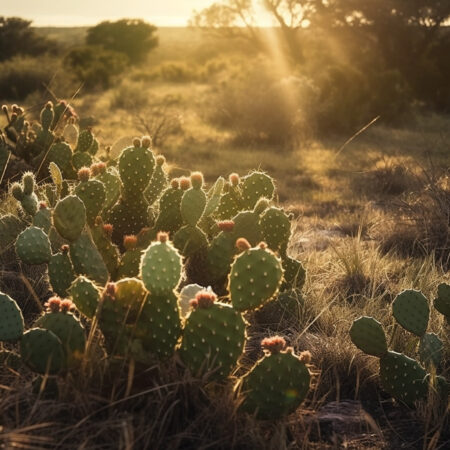Key Takeaways:
- Cacti play a crucial role in ecosystems, providing food, water, and habitat for various species.
- Threats to cacti on private land include urban development, agriculture, and illegal collection.
- Conserving cacti on private land helps maintain biodiversity and ecological balance.
- Creating cactus-friendly habitats, implementing effective propagation techniques, and addressing human-cactus interactions are important strategies for cactus conservation.
- Engaging private landowners, developing collaborative partnerships, and providing resources and support are crucial for successful cactus preservation efforts.
- Public awareness and education initiatives are essential in promoting cactus conservation and encouraging citizen science involvement.
The Importance of Cactus Conservation on Private Land
When we think of cacti, we often picture these desert-dwelling plants punctuating arid landscapes with their unique forms. However, cactus plants play a crucial role beyond their aesthetic appeal. They are resilient and adaptable, serving as key components of various ecosystems around the world. Protecting and conserving cacti, especially on private land, is essential for maintaining biodiversity and preserving the delicate balance of these ecosystems.
Understanding the Unique Role of Cacti in Ecosystems
Cacti serve as vital components of ecosystems for several reasons. Firstly, their structural attributes, such as spines and succulent tissues, help them survive in harsh environments with limited water availability. These adaptations make cacti important sources of food and water for a diverse range of animals, including insects, birds, reptiles, and mammals.
Additionally, cacti provide important nesting and sheltering sites for birds and small mammals. Their dense spines offer protection against predators, creating microhabitats that support the survival of many species. By preserving cacti on private land, landowners can actively contribute to the conservation of these diverse ecosystems and the species that depend on them.
The Threats Facing Cacti on Private Land
Despite their resilience, cacti face numerous threats on private land. Human activities, such as urban development, agriculture, and illegal collection, pose significant risks to cactus populations. Urbanization often results in habitat fragmentation, destroying large tracts of land that cacti rely on for survival. The conversion of natural areas for agriculture can lead to the loss of important cactus habitats.
Furthermore, the collection of cacti for horticultural trade and personal use has become a major threat to wild populations. Unregulated harvesting disrupts the natural balance and can lead to irreversible damage to cactus populations. These threats underline the importance of implementing effective conservation strategies on private land to safeguard the future of these iconic plants.
The Significance of Cactus Conservation for Biodiversity
Cactus conservation goes beyond protecting a single plant species; it is about safeguarding entire ecosystems and the biodiversity they support. Cacti provide critical resources and habitat for a wide range of organisms, making them a focal point for species interaction and ecological processes. By preserving cacti on private land, landowners can contribute to the maintenance of healthy and functioning ecosystems.
Furthermore, many cacti have unique ecological relationships that make them invaluable contributors to the overall biodiversity of an area. For example, some cacti have mutualistic relationships with specific pollinators, such as bats or insects. Preserving these specialized interactions ensures the survival of not only the cacti but also the dependent pollinators and other associated species.
Strategies for Protecting and Restoring Cactus Populations
Creating a Cactus-Friendly Habitat on Private Land
One of the most effective ways to conserve cacti on private land is to create and maintain suitable habitat conditions. Landowners can establish cactus-friendly areas by preserving existing cacti populations, restoring damaged habitats, and reintroducing native cacti species where they have been lost.
A key aspect of creating cactus-friendly habitat is ensuring proper land management practices. This includes minimizing the use of pesticides and herbicides, as these can harm cacti and the pollinators they rely on. Landowners can also implement measures to conserve soil moisture, such as mulching and rainwater harvesting, to create a more favorable environment for cacti to thrive.
Implementing Effective Cactus Propagation Techniques
To enhance cactus populations on private land, it is essential to implement effective propagation techniques. This can involve collecting cactus seeds or cuttings from healthy plants and cultivating them under controlled conditions. This practice helps increase genetic diversity and aids in the establishment of new populations.
Landowners can engage in cactus propagation by starting their own nurseries or participating in community-based propagation programs. By sharing knowledge and resources, private landowners can significantly contribute to the restoration and conservation of cacti populations.
Understanding and Addressing Human-Cactus Interactions
Human-cactus interactions are another critical aspect of cactus conservation on private land. Increasing awareness and understanding of the importance of cacti can help reduce destructive activities, such as illegal collection or habitat destruction. Landowners can play a significant role in educating visitors, neighbors, and local communities about the ecological significance and vulnerability of cacti.
Implementing signage and interpretive materials can help foster a sense of responsibility and respect towards cacti and their habitats. Landowners can also establish partnerships with local schools, universities, and environmental organizations to develop educational programs that promote cactus conservation.

Engaging Private Landowners in Cactus Conservation Efforts
Exploring the Benefits of Cactus Conservation for Landowners
Engaging private landowners in cactus conservation efforts requires highlighting the numerous benefits they can gain from protecting these plants. Cacti can increase property values by enhancing the aesthetic appeal of the landscape. Additionally, cacti provide valuable ecosystem services, such as soil stabilization and erosion control.
Landowners can also benefit from eco-tourism opportunities by showcasing the unique cactus species on their property. This can attract nature enthusiasts and contribute to local economies. By emphasizing these advantages, conservation organizations and government agencies can encourage private landowners to actively participate in cactus conservation projects.
Developing Collaborative Partnerships for Cactus Preservation
Collaborative partnerships between private landowners, conservation organizations, and government entities are crucial for the successful preservation of cacti on private land. These partnerships can involve sharing expertise, resources, and funding to implement conservation initiatives effectively.
Conservation organizations and government agencies can provide technical assistance and guidance to private landowners, helping them develop and implement management plans that prioritize cactus conservation. By establishing a framework for collaboration, all stakeholders can work towards a common goal of safeguarding cacti and their ecosystems.
Providing Resources and Support for Private Landowners
To encourage private landowners to engage in cactus conservation, it is essential to provide them with the necessary resources and support. This can include access to scientific research and best management practices that promote cactus conservation.
Government agencies and conservation organizations can offer financial incentives and grants to assist private landowners in implementing cactus conservation measures. Additionally, technical assistance, workshops, and training programs can equip landowners with the knowledge and skills needed to effectively manage and protect cacti on their properties.
The Role of Public Awareness and Education in Cactus Conservation
Creating an Appreciation for Cacti among the General Public
Public awareness and appreciation for cacti are essential for their long-term conservation. Through targeted campaigns, media engagement, and outreach programs, the general public can be educated about the ecological significance of cacti and the importance of their conservation.
Botanical gardens, nature centers, and educational institutions can play a vital role in this regard by creating exhibits and educational programs that highlight the beauty and uniqueness of cacti. By fostering a connection between people and cacti, we can inspire greater conservation efforts and support for cactus protection on private land.
Educating Communities on the Importance of Cactus Conservation
Engaging local communities is crucial for successful cactus conservation on private land. Community-based programs, such as workshops, seminars, and field trips, can educate residents about the importance of cacti and the threats they face.
By involving community members in hands-on conservation activities, such as habitat restoration and monitoring initiatives, individuals can develop a sense of ownership and pride in their local cactus populations. This sense of stewardship can lead to increased protection and conservation of cacti on private land.
Encouraging Citizen Science Initiatives for Cactus Research
Citizen science initiatives can greatly contribute to cactus research and conservation efforts. By involving the public in data collection, monitoring, and research projects, scientists can gather valuable information on cactus populations and their habitats.
Landowners can play an active role in citizen science initiatives by allowing researchers access to their private lands for data collection and monitoring. These collaborations not only enhance scientific knowledge but also increase public involvement and awareness, fostering a sense of shared responsibility for cactus conservation.
Overall, the conservation of cacti on private land demands a multi-faceted approach that combines habitat preservation, propagation techniques, community engagement, and public awareness. By implementing these strategies, private landowners can actively contribute to the preservation of cacti, ensuring their survival for future generations to enjoy and appreciate.
FAQ
Question: What are the threats to cacti on private land?
Urban development, agriculture, and illegal collection pose significant risks to cactus populations on private land. These activities result in habitat fragmentation, loss of important cactus habitats, and disruption of natural balance.
Question: What is the significance of cactus conservation for biodiversity?
Cactus conservation is not only about protecting a single plant species, but also about maintaining healthy ecosystems and supporting the biodiversity they depend on. Cacti provide critical resources and habitat for a wide range of organisms, contributing to species interaction and ecological processes.
Question: How can private landowners create cactus-friendly habitats?
Private landowners can create cactus-friendly habitats by preserving existing cacti populations, restoring damaged habitats, and reintroducing native cacti species. Proper land management practices, such as minimizing the use of pesticides and herbicides, and implementing measures to conserve soil moisture, also contribute to creating favorable conditions for cacti to thrive.
Question: What are effective cactus propagation techniques?
Effective cactus propagation techniques involve collecting cactus seeds or cuttings from healthy plants and cultivating them under controlled conditions. This helps increase genetic diversity and establish new populations. Landowners can start their own nurseries or participate in community-based propagation programs to contribute to cactus restoration and conservation.
Question: How can human-cactus interactions be addressed for conservation?
Raising awareness and understanding of the importance of cacti can help reduce destructive activities like illegal collection or habitat destruction. Landowners can educate visitors, neighbors, and local communities about the ecological significance and vulnerability of cacti through signage, interpretive materials, and partnerships with schools and environmental organizations.
Question: How can private landowners be engaged in cactus conservation efforts?
Private landowners can be engaged in cactus conservation efforts by highlighting the benefits they can gain, such as enhancing property values and attracting eco-tourism opportunities. Developing collaborative partnerships between landowners, conservation organizations, and government entities can provide the necessary resources, expertise, and funding for effective conservation initiatives.
Question: What resources and support are available for private landowners in cactus conservation?
Government agencies and conservation organizations can provide private landowners with access to scientific research, best management practices, financial incentives, grants, technical assistance, workshops, and training programs to promote cactus conservation.
Question: How can public awareness and education contribute to cactus conservation?
Public awareness and appreciation for cacti are essential for their long-term conservation. Botanical gardens, nature centers, and educational institutions can create exhibits and educational programs to highlight the beauty and uniqueness of cacti. Engaging local communities through workshops, seminars, field trips, and citizen science initiatives can educate residents, foster stewardship, and increase protection and conservation efforts.




Comments